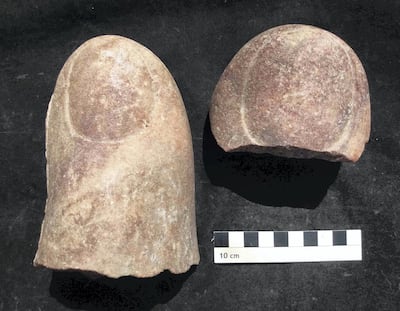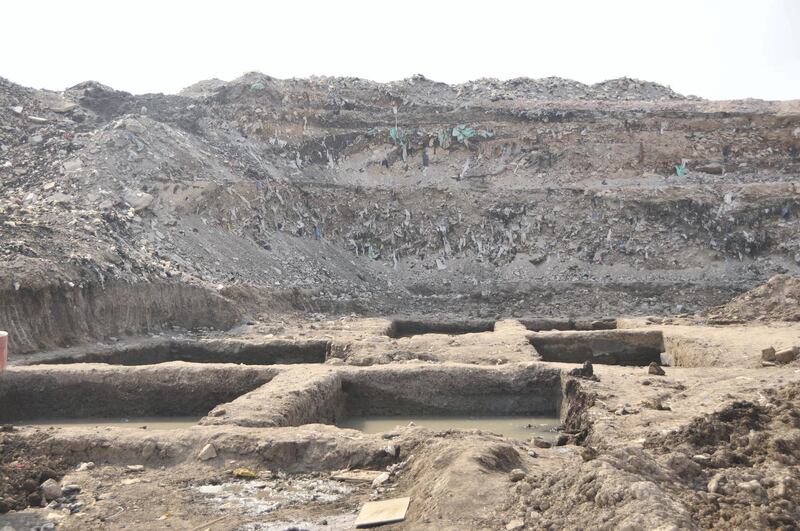Excavating the ancient city of Egypt's Heliopolis is not your stereotypical dig. At one archaeological site, workers had to remove trash that had been 13-metres deep before they could start on the dirt. For the archaeologists and antiquities officials, the most pressing challenges are modern, not ancient.
The site is in the north Cairo neighbourhood of Matareya, one of the most densely populated areas in the world. Each square kilometre of populated space in the district holds an average of 156,712 people.
“It has its own tasks and risks. Working there is much different than other sites,” says Dr Ayman Ashmawy, head of the ancient Egyptian sector at the ministry of antiquities. “They are so friendly, but also to work inside doesn't give you a lot of privacy and ability to work freely. It’s a special case, Matareya.”
Dr Ashmawy, along with Dr Dietrich Raue of the University of Leipzig, is the co-director of the Egyptian-German expedition. In March, between half-vacant apartment buildings reachable only by unpaved roads, the expedition unearthed a nearly eight-metre-high statue — possibly of Psamtik I who ruled Egypt from 664-610 BC. The team has since found three toes belonging to the statue.

The water table in the area has risen more than one metre since Dr Ashmawy started working on the site, he says. Self-built housing could be to blame, workers on the site said at the time, but also the water table in the areas north of Cairo has risen due to increasing sea levels.
Nearby, on a road leading to the site, Eid Megahed has had his appliance repair shop for 13 years. His family moved here 30 years ago, when it was mostly fields. He remembers Matareya when it was so full of antiquities that it was common for peddlers to wheel around carts with a couple dozen scavenged artefacts for sale.
The ancient city of Heliopolis had immense religious importance for some Egyptians. Egyptian mythology says that on this site the world was created and it is much larger than Karnak, one of Egypt’s most famous tourist attractions. The proximity of Heliopolis to Persian, and then Arab, settlements made it an easy source of quarried stone for their own building projects.
____________
Read more: Egypt digs up two statues dating back 3,000 years
____________
Now, most antiquities are small amulets or shards of stone or pottery. For historians, the material can hold much insight into ancient Egypt, but for general contractors, the artefacts may disappear into spill as they dig foundations.
This is why before any building can commence, contractors need to fill out a lot of paperwork to ensure they do not leave anything of historical value under apartment blocks or shopping malls. To do that, they need the signature of Matareya district's head of antiquities, Khaled Abou-Elalla, the man who stands between the growth of the city and the trove of antiquities underneath it.
“The next generation, all they’ll see is the history that we are writing now,” says Mr Abou-Elalla, whose office is near Matareya’s obelisk, where the city is hustling and bustling and the noise of traffic and construction is hard to ignore. “They’ll see this neighbourhood just as buildings and homes, they won’t see the antiquities.”
Areas without antiquities can get the ministry’s approval in about two months, he says. However, if there is an archaeological find, the process can take up to two or three years. Usually, he says, there is pressure from contractors or government entities to rush through the permits to encourage development — unless there is a government project under way already.
While Matareya is not a stereotypical location to dig, people living near or on archaeological sites is not unusual. In fact, it is a defining characteristic of Egyptology, as the areas suitable for habitation today are largely the same as those in ancient Egypt.
"A lot of the sites that we think of as uninhabited, some of them were sites of fairly dense human living," says Elliot Colla, associate professor of Arabic and Islamic Studies at Georgetown University and author of Conflicted Antiquities: Egyptology, Egyptomania, Egyptian Modernity. "The word I would use is entanglement: entanglement between artefacts from the Pharaonic era and people who live in modern Egypt. They occupy the same land.
“In a place like Egypt, which is densely populated, that there’s a conflict. There’s the people who live there now, versus an archaeologist who has a legitimate interest in knowing about the artefacts of the past.”
____________
Read more: Land of treasures
____________
Omnia Khalil, an urban anthropologist, says that it is important to balance the need for housing with preserving the past.
“There is confusion between having monuments and the living,” she says. “Why do we want to preserve the dead and kick people out without making any mediation or having some kind of solution? It’s a dilemma everywhere.”
Another issue lies in a lack of local interest in antiquities. Mr Abou-Elalla says there is no popular consciousness on the importance of antiquities beyond the immediate economic value that they create.
It is hard to imagine that much economic growth will be generated by these artefacts in Matareya itself. The statue that was exhumed in March was moved to the Egyptian Museum on Tahrir Square but is due to eventually be relocated 30km away to the Grand Egyptian Museum, which has yet to open.
Mr Abou-Elalla says there needs to be more public education on the artefacts. Matareya residents though will probably not see any of their neighbourhood's treasures in the exhibit unless they decide to make the hour-long trip to the new museum.
“To create the museum object, it has to be beyond monetary value, it has to have historical, artistic, or civilisation value and that can’t be reflected in money,” said Mr Colla. “When the object is in mud in a popular neighbourhood in metropolitan Cairo, that’s not a sacred object yet.
"In order to get from there to the museum, all its ties to modern Matareya need to be severed and decontextualised.”





